Sound training is essential for mastering audio techniques, enhancing creativity, and producing high-quality media. It empowers artists to craft immersive experiences, from music to film, fostering innovation and artistry.
1.1 Importance of Sound Training in Modern Media
Sound training is vital in modern media, as it enhances storytelling, emotional depth, and audience engagement. It enables creators to craft immersive soundscapes, align audio with visuals, and produce high-quality content. From film to music, sound design plays a crucial role in capturing attention and conveying messages effectively. Proper training ensures professionals can leverage advanced tools and techniques, delivering polished and impactful media experiences that resonate with diverse audiences.
1.2 Applications of Sound Training in Various Industries
Sound training is applied across multiple industries, including film, music, gaming, and advertising; It enhances audio quality, creates immersive experiences, and drives emotional engagement. In film, it synchronizes sound with visuals for cinematic impact; in music, it refines production and mixing. Gaming benefits from realistic sound effects, while advertising uses sound to capture attention. Additionally, sound training is crucial in live events, podcasting, and virtual reality, making it a versatile and essential skill for modern media professionals.
Foundational Concepts of Sound
Understanding sound’s basics, like frequency, amplitude, and waveforms, is crucial. It explores how sound propagates, its perception by humans, and key audio terminology, forming the core of sound education.
2.1 The Physics of Sound: Frequency, Amplitude, and Waveforms
Sound is a vibration that travels through mediums like air. Frequency, measured in Hz, determines pitch, while amplitude, in decibels, affects loudness. Waveforms visually represent sound’s oscillations. These principles are fundamental to understanding how sound behaves and is manipulated in audio applications. Grasping these concepts is essential for effective sound design and engineering.
2.2 Understanding Sound Perception and Human Hearing
Human hearing perceives sound waves within a specific range, typically 20 Hz to 20,000 Hz. Sound intensity, measured in decibels, and duration influence perception. The brain processes these vibrations, enabling us to distinguish pitch, tone, and rhythm. Factors like background noise and individual hearing variations affect sound perception. Understanding these principles helps in creating audio that aligns with human auditory capabilities, enhancing sound design and listener experience.
2.3 Basic Audio Terminology: Key Terms and Definitions
Understanding basic audio terminology is crucial for sound training. Key terms include frequency (pitch), amplitude (loudness), and waveform (visual representation of sound). Other essential terms are bitrate (data rate of audio), sample rate (samples per second), and signal-to-noise ratio (clarity vs. background noise). These terms form the foundation of audio processing and are vital for effective sound design and manipulation.

Setting Up a Home Sound Studio
Setting up a home sound studio requires essential gear like a computer, audio interface, microphones, headphones, and monitors. Ensure proper acoustic treatment for optimal sound quality.
3.1 Essential Equipment for Sound Training
The core equipment for sound training includes an audio interface, high-quality microphones, professional headphones, studio monitors, and a reliable computer. A digital audio workstation (DAW) is also crucial for recording and editing. Additionally, MIDI controllers and keyboards are essential for music production. Cables, stands, and acoustic panels are necessary for a professional setup. Each component plays a vital role in achieving high-quality sound and ensuring efficient workflow during training and projects.
3.2 Acoustic Treatment for Optimal Sound Quality
Acoustic treatment is vital for achieving professional-grade sound in any studio. It involves using materials like acoustic panels, bass traps, and diffusers to minimize echo, flutter, and unwanted reverberation. Proper treatment ensures accurate sound reproduction and mixing. Start by identifying problem areas in the room, then apply targeted solutions. A well-treated space enhances clarity, reduces distortion, and improves overall sonic accuracy, making it essential for effective sound training and production.

Tools and Software for Sound Design
Explore essential tools and software for sound design, including DAWs, plugins, and hardware, to create and manipulate audio effectively in various creative projects.
4.1 Overview of Digital Audio Workstations (DAWs)
Digital Audio Workstations (DAWs) are software platforms for recording, editing, and producing audio. They provide tools for multitrack recording, MIDI sequencing, and effects processing. Popular DAWs include Ableton Live, Logic Pro, and FL Studio. These programs allow users to create, edit, and mix audio projects, making them essential for sound design and music production. DAWs are versatile, catering to both professional studios and home setups, enabling artists to bring their creative visions to life with precision and efficiency.
4.2 Popular Plugins and Effects for Sound Manipulation
Plugins and effects are essential tools for sound manipulation in DAWs. Reverb adds spatial depth, while delay creates rhythmic interest. EQ shapes frequencies, and compression controls dynamics. Distortion and saturation introduce grit, while pitch-shifters and time-stretchers alter audio characteristics. Popular plugins like FabFilter Pro-Q and Waves C4 offer precise control. These tools enable creators to enhance, transform, and refine audio, making them indispensable for professional sound design and music production. They expand creative possibilities, ensuring high-quality results in various projects.
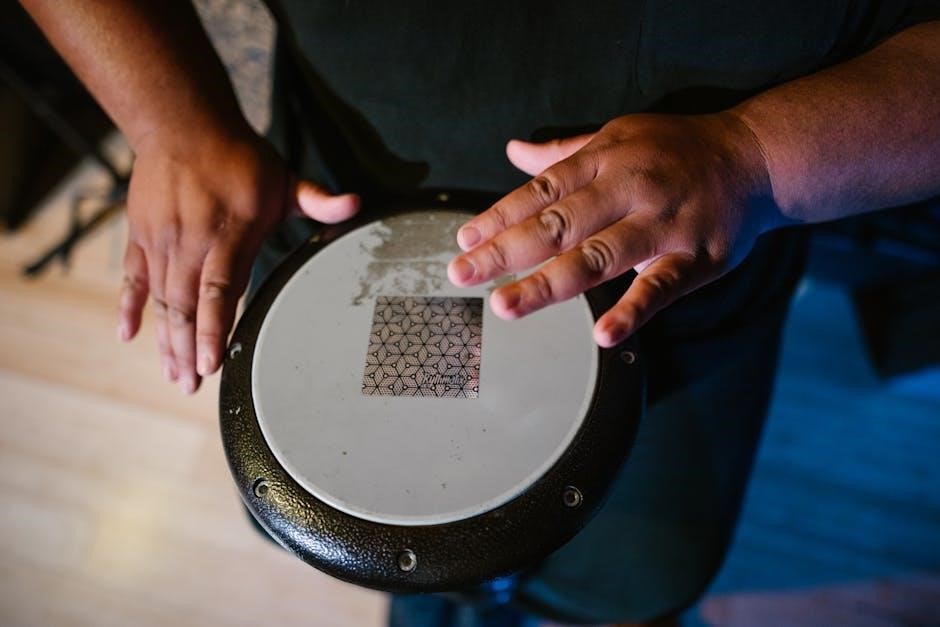
Sound Recording Techniques
Sound recording techniques involve capturing audio with precision and clarity. Proper microphone selection, placement, and room acoustics ensure high-quality results. Understanding signal flow from mic to DAW is key. Techniques like setting optimal levels, using headphones for monitoring, and minimizing background noise are essential for professional recordings. These methods help achieve clear, distortion-free audio, forming the foundation of successful sound projects.
5.1 Best Practices for Capturing High-Quality Audio
For high-quality audio capture, ensure a quiet environment with minimal background noise. Use high-grade microphones and cables, and position them correctly. Set optimal gain levels to avoid distortion. Monitor audio using headphones to detect issues in real-time. Record in lossless formats like WAV for superior fidelity. Perform multiple takes to achieve the best results. Organize files neatly and maintain consistent recording levels for a polished final output. These practices ensure clarity, precision, and professional-grade audio capture.
5.2 Microphone Selection and Placement Strategies
Selecting the right microphone is crucial for achieving desired sound quality. Dynamic mics are ideal for loud sources, while condenser mics capture detailed, nuanced audio. Ribbon mics offer warm, natural tones. Placement is key: position mics to minimize background noise and optimize sound capture. Use proximity to enhance intimacy or distance for a natural balance. Experiment with angles to reduce harsh frequencies. Invest in a quality mic stand and consider using windscreens or pop filters to control plosives and environmental interference. Proper placement ensures clear, professional recordings.
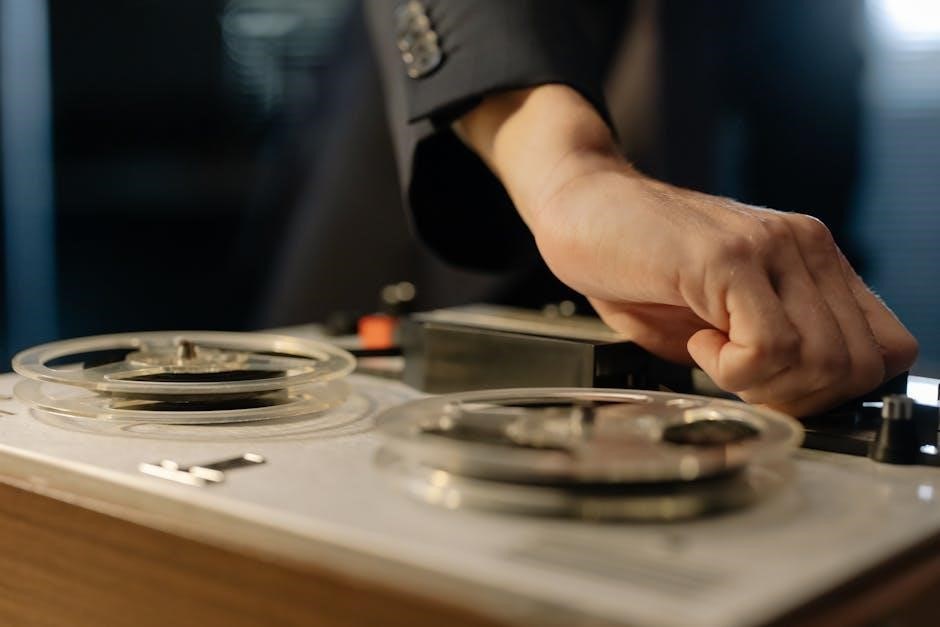
Sound Mixing and Editing
Sound mixing and editing involve creating clear, professional audio by balancing levels, refining tracks, and ensuring cohesion. Precision and creativity are key to achieving polished results.
6.1 Layering and Balancing Audio Tracks
Layering and balancing audio tracks are critical steps in sound mixing. This process involves arranging and adjusting the volume, pan, and depth of each track to create a cohesive mix. Proper layering ensures no single element overwhelms others, while balancing achieves a harmonious blend. Techniques like EQ and compression help refine frequencies and dynamics, ensuring clarity and space within the mix. Effective balancing enhances the overall listening experience by creating depth and dimension in the audio landscape.
6.2 Advanced Editing Techniques: EQ, Compression, and Reverb
Advanced editing techniques like EQ, compression, and reverb are essential for refining audio. EQ adjusts frequencies to enhance clarity, while compression controls dynamics for consistent levels. Reverb adds spatial depth, simulating real or imagined environments. These tools, when used skillfully, enhance the emotional impact of sound and create a polished, professional mix. Mastering these techniques is key to achieving high-quality audio for various applications, from music production to post-production in film and media projects.

Sound Design for Art and Creativity
Sound design unlocks creative expression, transforming audio into a powerful artistic medium. By manipulating frequencies, textures, and layered sounds, artists craft unique sonic experiences that evoke emotion and imagination, enhancing visual and multimedia projects with depth and originality.
7.1 Creating Unique Sound Effects from Scratch
Creating unique sound effects from scratch involves a blend of creativity and technical skill. Start by capturing or synthesizing raw sounds using field recordings or software tools like Ableton or FL Studio. Experiment with audio manipulation techniques such as pitch shifting, time stretching, and layering to craft distinctive effects. Add depth with effects like reverb, delay, or distortion. For synchronization, use software to align sounds with visuals, ensuring emotional impact by matching the sound’s tone and intensity to the scene. Practice and iteration are essential to refine your craft and achieve professional-quality sound effects.
7.2 Integrating Sound Art into Multimedia Projects
Integrating sound art into multimedia projects enhances the sensory experience by harmonizing auditory elements with visual and narrative components. Start by conceptualizing how sound can complement the project’s theme and emotions. Use digital tools like Ableton or Logic Pro to design and edit unique soundscapes. Incorporate field recordings for authenticity or create synthetic sounds for a futuristic feel. Ensure synchronization by timing sound effects and music to align with visual cues, using software for precise editing. Consider interactivity, where audience actions influence sounds, adding depth and engagement. Experiment with tools and techniques to refine your approach, balancing creativity with technical execution to achieve a cohesive and impactful multimedia experience.
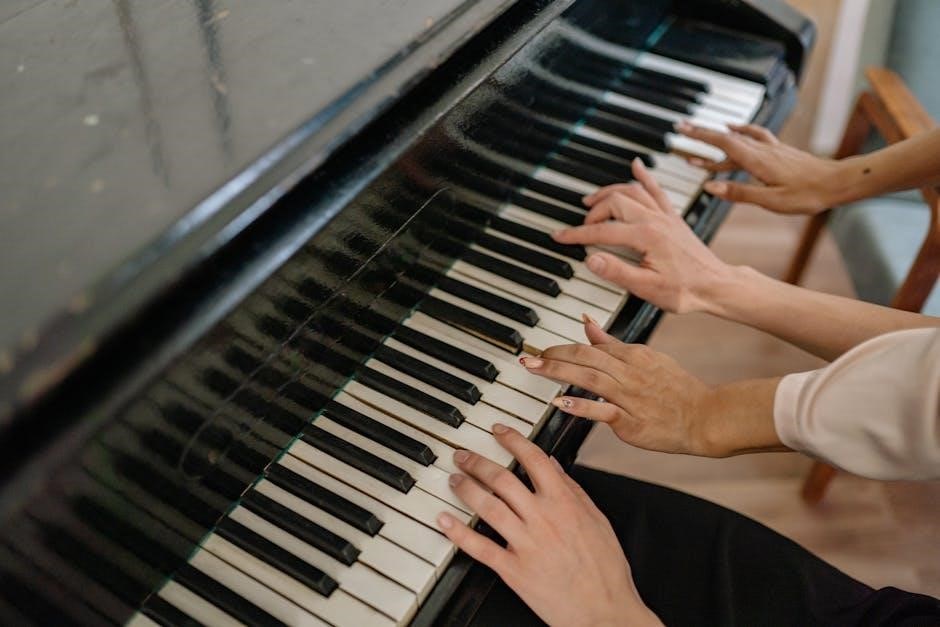
Sound Training for Film and Video Production
Sound training is vital for film and video production, ensuring high-quality audio that enhances visual storytelling. Learn to capture, edit, and synchronize sound for cinematic impact and professionalism.
8.1 Syncing Sound with Visuals: Timing and Flow
Syncing sound with visuals is crucial for immersive storytelling. Proper timing ensures dialogue, sound effects, and music align seamlessly with on-screen actions; Use timecode and digital audio workstations (DAWs) to precision-match audio cues. Preview and fine-tune synchronization to maintain visual-audio harmony, enhancing the overall narrative flow and audience engagement.
8.2 Designing Immersive Soundscapes for Cinematic Experiences
Immersive soundscapes in cinema are crafted by layering background noise, dialogue, sound effects, and music to create a three-dimensional auditory environment. Techniques like 3D audio and surround sound systems enhance spatial perception, making viewers feel part of the scene. Proper balancing ensures clarity while evoking emotional depth. For instance, ambient forest sounds or bustling city noise can transport audiences, heightening engagement and emotional connection to the cinematic experience.
Sound Training for Music Production
Mastering music production involves understanding frequency manipulation, audio layering, and dynamic processing. Essential tools include EQ, compression, and reverb to shape sound and create depth, ensuring polished mixes that captivate listeners emotionally and sonically, while maintaining clarity and balance across genres and styles.
9.1 Enhancing Musical Elements with Sound Design
Enhancing musical elements with sound design involves transforming raw audio into captivating sonic experiences. Techniques like layering, filtering, and granular synthesis can elevate melodies and rhythms, adding depth and texture. Incorporating creative effects such as reverse audio, time-stretching, and spatial processing can redefine a track’s identity. By experimenting with harmonic layers, percussive elements, and ambient pads, producers can craft unique sounds that stand out. Tools like synthesizers and samplers further enable the creation of intricate auditory landscapes, enhancing emotional impact and listener engagement.
9.2 Using Sound to Create Emotional Depth in Music
Sound design plays a crucial role in evoking emotions in music by shaping the listener’s experience. Dynamics, tempo, and frequency range can convey tension, calmness, or joy. Strategic use of reverb and delay creates spatial depth, while distortion and saturation add intensity. Layering harmonics and subtle textures enhances emotional complexity. By aligning sound elements with the song’s narrative, artists can create a connection with the audience, making the music more relatable and impactful on an emotional level.
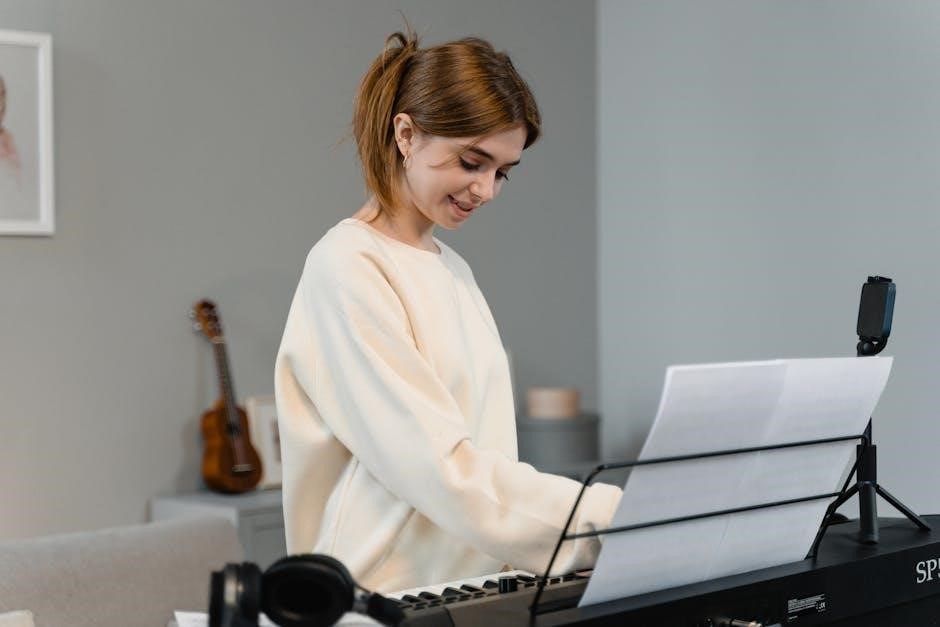
Resources for Sound Training
Explore online courses, forums, workshops, books, and software tutorials to enhance sound training. These resources offer hands-on experience and knowledge on tools, techniques, and best practices.
10.1 Recommended Online Courses and Tutorials
Discover a variety of online courses and tutorials designed to enhance your sound training. Platforms like Udemy, Coursera, and Skillshare offer courses such as Sound Design Fundamentals and Audio Production Basics. These resources provide step-by-step guidance, covering topics like DAW usage, audio editing, and sound manipulation. Many courses include hands-on projects, allowing you to apply your skills in real-world scenarios. Specializations like Sound for Film on LinkedIn Learning can deepen your expertise in specific areas.
10.2 Communities and Forums for Sound Enthusiasts
Engage with vibrant online communities and forums dedicated to sound enthusiasts. Platforms like Reddit’s r/WeAreTheMusicMakers and r/AudioProduction offer spaces for discussing sound design, sharing projects, and learning from peers. Gearslutz and Facebook groups like Sound Design provide valuable resources and networking opportunities. These communities foster collaboration, feedback, and inspiration, helping you stay updated on industry trends and best practices in sound training and audio production.
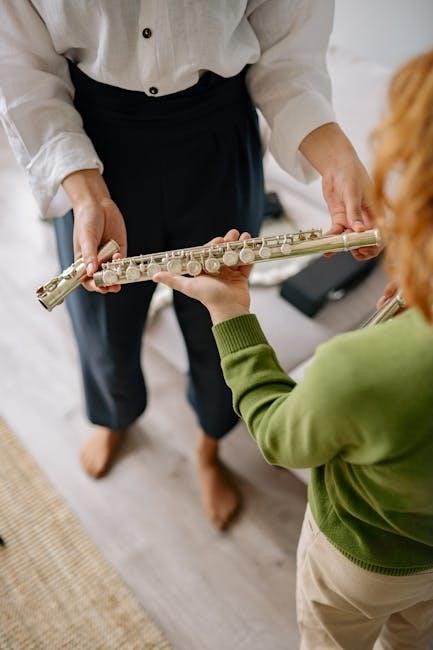
Advanced Sound Training Techniques
Explore advanced sound training techniques, pushing creative boundaries with generative tools, AI integration, and immersive audio design to elevate your sound artistry and technical expertise.
11.1 Experimenting with Generative Sound Tools
Generative sound tools offer innovative ways to create dynamic audio by using algorithms and random processes. These tools allow users to experiment with unique sound textures, patterns, and evolving compositions. By leveraging probability and automation, artists can craft intricate soundscapes that transcend traditional recording methods. Generative techniques encourage creativity and unpredictability, enabling the exploration of new sonic territories. They are particularly useful for ambient music, sound art, and experimental projects, pushing the boundaries of what sound design can achieve.
Exploring generative tools requires a balance between technical understanding and artistic intuition. Users can manipulate parameters like frequency, amplitude, and timbre in real-time, creating immersive and ever-changing audio experiences. These tools not only expand creative possibilities but also foster innovation in sound training, making them essential for modern sound designers seeking to innovate and differentiate their work.
11.2 Incorporating AI in Sound Design Processes
AI is revolutionizing sound design by automating complex tasks and enhancing creative workflows. Machine learning algorithms can analyze audio patterns, generate unique sounds, and even mimic styles. AI tools like adaptive EQ and smart compression enable real-time adjustments, ensuring optimal sound quality. These technologies also facilitate experimentation, allowing designers to explore unconventional sonic possibilities with ease. AI-driven systems are becoming indispensable for streamlining processes and pushing the boundaries of sound design.
By integrating AI, sound designers can focus more on artistic vision while delegating technical tasks to algorithms. AI assists in noise reduction, speech enhancement, and even composing music. It bridges the gap between human creativity and technical precision, offering unprecedented control over sound. As AI continues to evolve, its role in sound design will expand, providing innovative solutions for modern audio challenges and inspiring new creative approaches in the industry.

Case Studies in Sound Training
Explore real-world applications of sound training in film, gaming, and live events. Analyze successful projects, highlighting strategies that enhanced audio quality and creativity.
12.1 Successful Projects and Their Sound Design Strategies
Examine landmark projects like Inception and The Revenant, where sound design played a pivotal role. Learn how techniques like precise layering and realistic Foley recording created immersive experiences. Discover how these strategies enhanced storytelling and emotional impact, offering practical insights for sound training enthusiasts to apply in their own work.
Sound training is a dynamic field, blending art and technology. Continuous learning and practice are key to mastering its ever-evolving techniques and applications.
13.1 Summing Up Key Concepts
Sound training encompasses a blend of technical knowledge and creative practices. From understanding sound physics to mastering recording and mixing, the manual highlights essential skills for various industries. It emphasizes the importance of quality equipment, acoustic treatment, and software tools. Practical techniques like microphone placement and audio editing are covered, along with creative sound design for film, music, and art. Continuous learning and experimentation are encouraged to stay updated in this evolving field;
13.2 Encouragement for Continuous Learning and Practice
Continuous learning and practice are vital for mastering sound training. The field evolves rapidly, with new tools and techniques emerging regularly. Stay curious, experiment with creative approaches, and refine your skills through hands-on projects. Set achievable goals, seek feedback, and explore diverse genres to broaden your expertise. Engaging with sound communities and professionals can inspire growth and provide valuable insights. Dedication and persistence will unlock your full potential in sound design and audio production.
